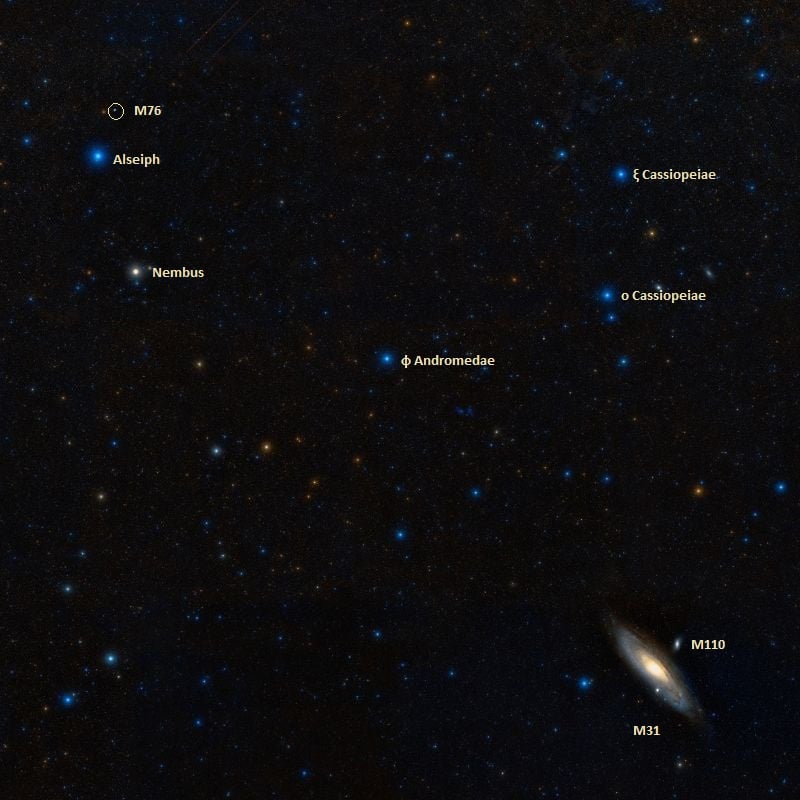Welcome back to Messier Monday! Today, we continue in our tribute to our dear friend, Tammy Plotner, by looking at the "little dumbbell" itself, the planetary nebula known as Messier 76!
During the 18th century, famed French astronomer Charles Messier noticed the presence of several "nebulous objects" while surveying the night sky. Originally mistaking these objects for comets, he began to catalog them so that others would not make the same mistake. Today, the resulting list (known as the
Messier Catalog
) includes over 100 objects and is one of the most influential catalogs of Deep Space Objects.
One of these objects is the Messier 76 (aka. the Little Dumbbell Nebula, the Barbell Nebula, or the Cork Nebula) a planetary nebula located about 2,500 light years away in the
Perseus Constellation
. While it is easy to find because of its proximity to the
Cassiopeia Constellation
(located just south of it), the faintness of this nebula makes it one of the more difficult Messier Objects to observe.
Description:
Located some 2,500 light years away from Earth, the shell of this dying star expands over space for a distance of about 1.23 light years - yet the halo around it continues on for close to another 12. Inside is a 16.6 magnitude central star, burning away at a temperature of approximately 60,000 K!
[caption id="attachment_141200" align="aligncenter" width="580"]
Image of The Little Dumbbell Nebula taken by the Liverpool Telescope. Credit: Göran Nilsson, Wim van Berlo/The Liverpool Telescope
[/caption]
One day, perhaps in another 30 billion years, it will cool down a bit, becoming a white dwarf star. But just what makes its shape - its shape? As Toshiya Ueta of the NASA Ames Research Center said in a
2006 study
:
"We present the far-infrared (IR) maps of a bipolar planetary nebula (PN), NGC 650, at 24, 70, and 160 [nanometers], taken with the Multiband Imaging Photometer for Spitzer (MIPS) on board the Spitzer Space Telescope. While the two-peak emission structure seen in all MIPS bands suggests the presence of a near edge-on dusty torus, the distinct emission structure indicates the presence of two distinct emission components in the central torus. Based on the spatial correlation of these two far-IR emission components with respect to various optical line emission, we conclude that the emission is largely due to the [O IV] line arising from highly ionized regions behind the ionization front, whereas the other emissions are due to dust continuum arising from low-temperature dust in the remnant asymptotic giant branch (AGB) wind shell. The far-IR nebula structure also suggests that the enhancement of mass loss at the end of the AGB phase has occurred isotropically, but has ensued only in the equatorial directions while ceasing in the polar directions. The present data also show evidence for the prolate spheroidal distribution of matter in this bipolar PN. The AGB mass-loss history reconstructed in this PN is thus consistent with what has been previously proposed based on the past optical and mid-IR imaging surveys of the post-AGB shells."
So it's bi-polar - just another crazy planetary nebula. But could it be blowing bubbles? According to some researchers, it could. These include M. Bryce (et al), who indicated the following in a
1996 study
:
"High spatial and spectral resolution observations of the H?, [N II]6584A and [O III]5007A emission line profiles from the planetary nebula NGC 650-1 have been obtained with the Isaac Newton and William Herschel Telescopes using the Manchester echelle spectrometer. These observations, and additional narrow-band images obtained using the San Pedro Martir telescope, are compared with synthesised images and spectra based on the generalised interacting stellar winds (GISW) models (involving a slow wind strongly concentrated towards the equatorial plane) and a good correspondence is found, confirming NGC 650-1 to be a bipolar wind-driven bubble orientated at an inclination of ~75deg with the NW lobe pointing towards the observer. There is a bright central ring with two attached (inner) lobes, which show typical expansion velocities of ~43km/s and ~60km/s respectively. Outside the inner lobes are the fainter outer lobes which are observed to have a very low expansion velocity (~5km/s), and which have on one side (SE) a polar cap which shows higher velocities again (~20km/s). The nature of these outer lobes remains unclear."
[caption id="attachment_141201" align="aligncenter" width="580"]
The Little Dumbbell Nebula (M76). Credit: Adam Block/Mount Lemmon SkyCenter/University of Arizona
[/caption]
History of Observation:
One thing is very clear - this faint shell was discovered by Pierre Mechain on the night September 5th, 1780. He then handed it over to Charles Messier, who observed it, determined its position and added it to his catalog as object #76 on October 21st, 1780.
"Nebula at the right foot of Andromeda, seen by M. Mechain on September 5, 1780, and he reports: "This nebula contains no star; it is small and faint". On the following October 21, M. Messier looked for it with his achromatic telescope, and it seemed to him that it was composed of nothing but small stars, containing nebulosity, and that the least light employed to illuminate the micrometer wires causes it disappear: its position was determined from the star Phi Andromedae, of fourth magnitude."
In 1787, Sir William Herschel would privately study Mechain's find and be the first to see a dual form: "Two nebulae close together. Both very bright. Distance 2'. One is south preceding and the other north following. One is 76 of the Connoissance." Since that time, most observers perceive two distinct regions and perhaps even more? Just ask historical astronomer, Admiral Smyth:
"An oval pearly white nebula, nearly half-way between Gamma Andromedae and Delta Cassiopeiae; close to the toe of Andromeda, though figured in the precincts of Perseus. It trends north and south, with two stars preceding by 11s and 50s, and two following nearly on the same parallel, by 19s and 36s; and just np of it is the double star above registered, of which A is 9 magnitude, white; and B 14, dusky. When first discovered, Mechain considered it a mass of nebulosity; but Messier thought it was a compressed cluster; and William Herschel that it was an irresolvable double nebula. It has an intensely rich vicinity, and with its companions, was closely watched in my observatory, as a gauge of light, during the total eclipse of the moon, on the 13th of October, 1837, being remarkably well seen during the darkness, and gradually fading as the moon emerged. In 1842, I consulted Mr. Challis upon the definition of this nebula in the great Northumberland equatorial, and he replied: "I looked at the nebula, as you desired, and thought it had a sprangled appearance. The resolution, however, was very doubtful."
[caption id="attachment_141203" align="aligncenter" width="580"]
The location of Messier 76 in the Perseus Constellation. Credit: IAU and Sky & Telescope magazine (Roger Sinnott & Rick Fienberg)
[/caption]
Locating Messier 76:
Because this planetary nebula is small and faint, it isn't a good binocular target and will require dark skies even for a telescope. The easiest way to find the M76 is to start from the 3.5 magnitude star 51 Andromedae and make you way about a finger width (2 degrees) north-northeast until you come to 4th- magnitude Phi Persei, a variable star. From here aim your telescope less than a degree northwest of the star, and you will have M76 in the eyepiece field of view.
In a small telescope, you'll see a distinctive, odd-shaped glow that will take on more structure and form as aperture increases. Very large telescopes will not only see double lobed structure, but the additional faint halo ring as well. Not for light polluted skies or moonlit nights!
- Object Name
-
Messier 76
- Alternative Designations
-
M76, NGC 650/651, Little Dumbbell Planetary, Cork Nebula, Butterfly Nebula, and Barbell Nebula
- Object Type
-
Planetary Nebula
- Constellation
-
Perseus
- Right Ascension
-
01 : 42.4 (h:m)
- Declination
-
+51 : 34 (deg:m)
- Distance
-
3.4 (kly)
- Visual Brightness
-
10.1 (mag)
- Apparent Dimension
-
2.7x1.8 (arc min)
We have written many interesting articles about Messier Objects and
globular clusters
here at Universe Today. Here's Tammy Plotner's
Introduction to the Messier Objects
,
M1 – The Crab Nebula
,
Observing Spotlight – Whatever Happened to Messier 71?
, and David Dickison's articles on the
2013
and
2014
Messier Marathons.
Be sure to check out our complete
Messier Catalog
. And for more information, check out the
SEDS Messier Database
.
Sources:
- *NASA - Messier 76*
- Messier Objects - Messier 76: Little Dumbbell Nebula
- *SEDS - Messier Object 76*
- Wikipedia - Little Dumbbell Nebula
 Universe Today
Universe Today
